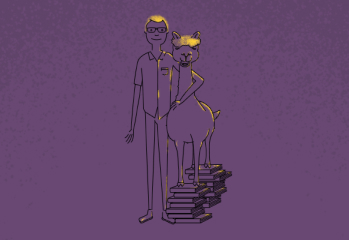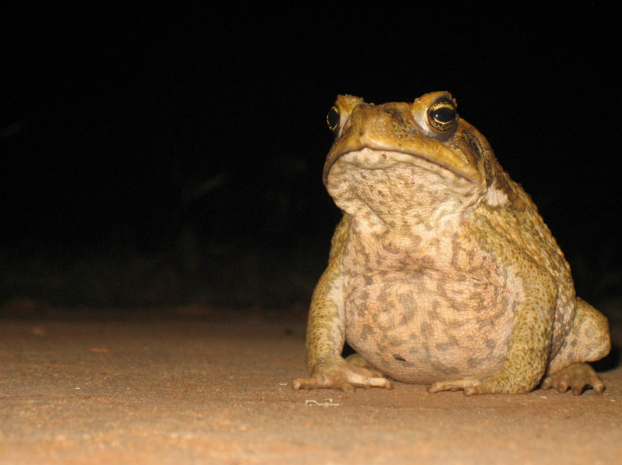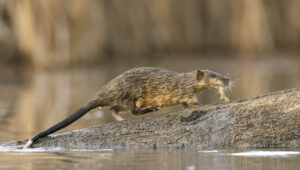In 1935, a species known as the giant neotropical toad (Rhinella marina) was introduced to Australia.
Scientists hoped these amphibians would control native cane beetles, but cane toads quickly colonised the country and had no discernible impact on beetle populations.
Many different methods are being tested to remove these warty beasts, including a toad containment zone and turning the toads into sausages.
Now, almost a century later, scientists believe they have finally stumbled across a potential solution to one of the worst invasive species ever.
Will clever gene-editing techniques finally rid this continent of the dreaded cane toad?
Toads in Neverland
Professor Emeritus Rick Shine led the team behind the new idea, based on CRISPR gene-editing techniques.
Caption: Professor Rick Shine with his slimiest nemesis
Credit: Chedds1, CC BY 4.0, via Wikimedia Commons
“We seem to have found a chink in the toads’ armour,” says Rick.
“If we could only stop their metamorphosing, we could have these eternal tadpoles,” he says.
Searching for collaborators to test this cunning plan, Rick happened across molecular biologist Dr Maciej Masielko, who was immediately struck by the beauty of the idea.
“We know enough about the biochemistry of metamorphosis to know what we would need to do,” says Maciej. “Like using CRISPR-Cas9 to delete a part of the cane toad’s DNA.”
CRISPR-Cas9 is a game-changing tool that emerged roughly a decade ago.
Essentially, it enables scientists to cut out and even replace sections of an organism’s genome.
“We take a freshly fertilised egg … and we take a little glass needle that has the Cas9 mixture,” says Maciej, “and inject that into the egg.”
The resultant tadpole will be able to produce offspring completely lacking the metamorphosis gene, which has led to them being likened to Peter Pan.
By removing the metamorphosis gene, the primary thing that changes about the toads is that they’ll be locked in as tadpoles.
Tadpoles for dinner?
The ball started rolling when one of Rick’s postdocs, Michael Clark, realised that the tadpoles were very fond of eating one another.
Since a single clutch can contain up to 30,000 eggs, hatchlings are born surrounded by a plentiful food source.

Credit: Supplied Terri Shine
When the researchers realised the tadpoles are cannibals, all of a sudden stopping them from metamorphosing became a viable strategy.
This cannibalistic behaviour hasn’t been observed in South America, the cane toad’s original habitat.
Fortunately, the mutant tadpoles will grow fat on a diet of their own siblings and eventually die of old age after a couple of months.
Early trials indicate they aren’t interested in native frog or fish eggs either.
What’s more, the resultant tadpoles are not classified as genetically modified organisms under Australian law.
“These are mutations, exactly like what happens in every clutch of toad eggs,” says Rick. “We’re essentially sterilising the animal, so it really doesn’t pose an ecological risk.”
“We’re not giving them some new superpower,” he says. “They’re just not able to do what most toads can do.”
Hopping along
Rolling out this solution represents a significant challenge.
The trait needs to be passed on to the next generation, and since they’re sterile, that’s a little tricky.
Maciej explains that, after the mutant tadpole has the required trait in its DNA, they must reintroduce the missing hormone in the lab. Once they are again able to reproduce, a percentage of their offspring will inherit the mutation.
The scientists have also customised their unique toads to be albino – that way you can tell which ones pose no risk and should be saved from the cricket bat.
Caption: An albino cane toad tadpole with a taste for its own flesh
Credit: Supplied Etienne Littlefair
Even then, spreading the cannibalistic tadpoles out in the wild is no simple job. We can’t just go around injecting CRISPR-Cas9 into hundreds of thousands of eggs.
Trials will take place in northern WA in the isolated, man-made dams that cane toads rely on for their ongoing westward march.
Unfortunately, for every billabong you fill with Peter Pans, there are another 10 chock-a-block with the incredibly resilient normal toads.
Rick says that this will work best in conjunction with other strategies. His team is also working on genetically editing toads to make them less poisonous.
“I would be astonished if we could actually eradicate toads using the kinds of methods we’re talking about,” says Rick.
“But I think we could massively knock down their numbers and make them a relatively scarce animal.”









